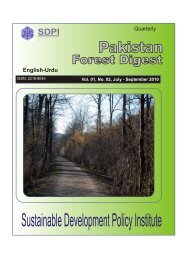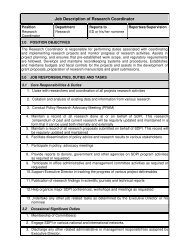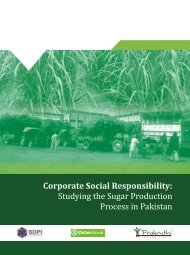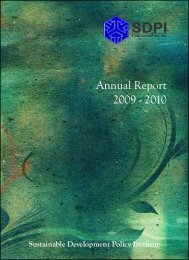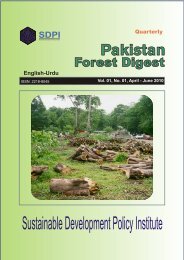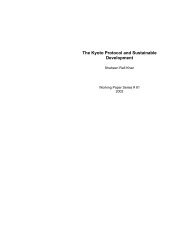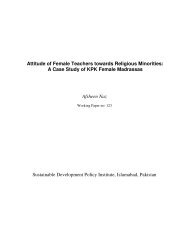Past, Present and Future 1Muhammad Asif Wazir Policy Brief # 35
Past, Present and Future 1Muhammad Asif Wazir Policy Brief # 35
Past, Present and Future 1Muhammad Asif Wazir Policy Brief # 35
You also want an ePaper? Increase the reach of your titles
YUMPU automatically turns print PDFs into web optimized ePapers that Google loves.
IntroductionPakistan is one of the largest <strong>and</strong> fastest growing countries in the world. In 2010, it ranked 6thmost populous country <strong>and</strong> will st<strong>and</strong> at 4th in 2050. Pakistan’s rapid population growth, duringthe second half of the 20th century, can largely be explained by the conventional demographictransition theory i.e. rapid decline in mortality rate combined with a gradual decline in fertilityrate. Consequently, the country’s population has been growing untamable since independencein 1947 i.e. from 34 million reported in the first census in 1951 to 132 million in 1998 <strong>and</strong>estimated at 183 million inhabitants in 2012.Since the 1950, Pakistan has experienced a significant population growth rate ranging betweentwo to four per cent per annum. During the period of 1950-1985, the country’s population hadgrown at the average rate of 3 per cent per annum. However, it declined to an average of 2.6per cent per annum during the period 1986-2000. In 2010, the population growth rate inPakistan was 1.8 per cent. Pakistan is likely to continue experiencing population growth in thenear <strong>and</strong> distant future at least until 2050 <strong>and</strong> more so than any other world region except sub-Saharan Africa. Thus, rapid population growth in Pakistan hindered the socio-economicdevelopment in the past <strong>and</strong> it will have to adopt the development model capable to absorb theincrease. If country fails, it will be confronted with several major risks, including politicalinstability <strong>and</strong> poverty trap.Pakistan has remarkably young age structure. In 2010, nearly two-thirds of the Pakistanipopulation was less than 30 years old with a median age of 21.7 years. The young age structurehas been persistent in Pakistan for the last five decades. The share of school age population(0-14 years old) was on the average 40 per cent from 1950s to 2000 <strong>and</strong> estimated at 36 percent (61 million) in 2010. The share of working-age population (15-64 years old) has beengrowing from 54 per cent in the 1950s to 61 per cent in 2010 (See table 1). Currently, the SouthAsian region along with Sub-Saharan Africa is the only region in the world with a young agestructure <strong>and</strong> significant population growth. Within South Asia, Pakistan st<strong>and</strong>s out with thehighest population growth rate <strong>and</strong> very young age structure.The fertility transition did not keep pace with the mortality decline in the past. In Pakistan, it wasexpected to start in the 1970s as a response to mortality transition. However, due to politicalinstability, low socio-economic development <strong>and</strong> ineffective population policies, the targets forreducing fertility were not accomplished, even until recently. Thus, fertility level in the decadesof 1970s <strong>and</strong> 1980s in Pakistan had remained exceptionally high <strong>and</strong> fluctuating between six<strong>and</strong> seven children per women. It is a well accepted fact that fertility decline in Pakistan startedonly in the late 1980s <strong>and</strong> later gained momentum in the 1990s.Several factors contributed significantly to the fertility decline during the last decade of 20thCentury in Pakistan such as overall socio-economic development, increased literacy <strong>and</strong>educational attainment particularly for female, <strong>and</strong> strengthening of family planningprogrammes. However, Pakistan had the highest fertility rates in 2006 among South Asiancountries <strong>and</strong> most of the nations across the globe, except for Sub-Saharan Africa. Pakistan stillhas very high fertility rate i.e. 4.1 children per women. It is worth mentioning here that female1


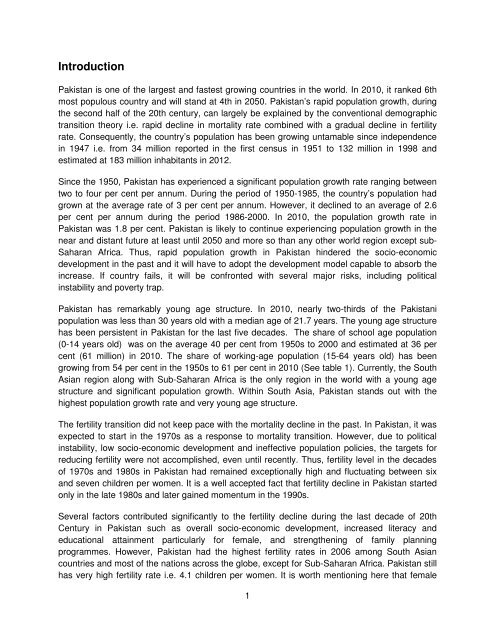
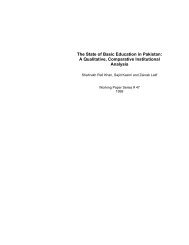
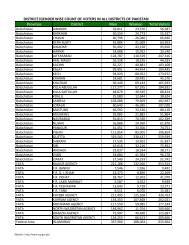
![(October - December, 2010) [13th SDC Special Bulletin]](https://img.yumpu.com/50118608/1/184x260/october-december-2010-13th-sdc-special-bulletin.jpg?quality=85)
